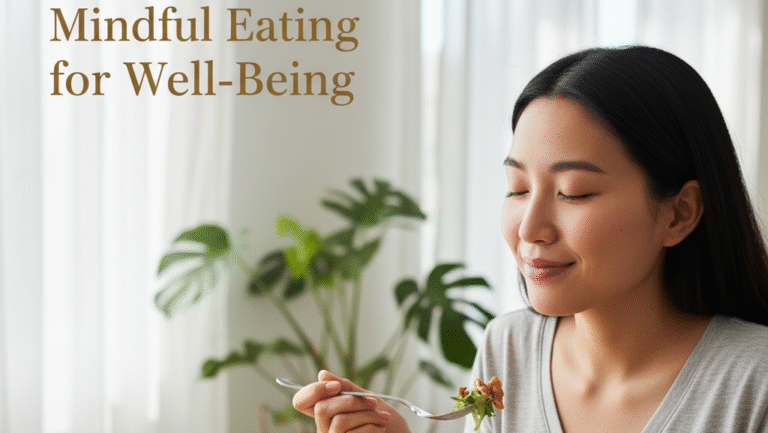Mindfulness vs Meditation: What’s the Difference?

Introduction to Mindfulness vs Meditation
Mindfulness and meditation often get bundled together, but they aren’t identical. Think of meditation as a training session, a structured practice that strengthens attention and awareness. Mindfulness is the everyday skill, staying present, curious and kind in real life. Meditation builds mindfulness; mindfulness is how you bring that steadiness into conversations, commutes, emails and meals.
What Is Mindfulness (Really)?
Working definition: Paying attention to what’s happening right now in your body, mind and surroundings with an attitude of curiosity and without rushing to judge it.
Foundational attitudes
- Intention: Choose to be here for this moment.
- Attention: Notice sensations, thoughts, sounds, and feelings.
- Non-judgement: Let go of “good/bad”; aim for “Oh, that’s interesting.”
- Kindness: Speak to yourself like you would to a friend.
- Beginner’s mind: Meet each moment as if you’ve never seen it before.
- Patience: Change unfolds at its own pace.
Everyday applications
- Mindful emails: One breath before you hit send; reread with warm intent.
- Mindful meetings: Feel your feet on the floor while listening.
- Mindful eating: Put down cutlery between bites; notice texture and flavour.
- Mindful commuting: Use red lights or platform waits as breath cues.
- Mindful pauses: Three slow breaths when the phone buzzes.
Why it’s helpful (in plain English)
- Encourages you to respond rather than react.
- Reduces mental clutter and rumination.
- Builds emotional granularity (naming what you feel helps you handle it).
- Can improve sleep by downshifting before bed.
What Is Meditation?
Working definition: A set of practices that train attention and awareness to cultivate qualities like calm, clarity and compassion.
Popular styles (pick one that fits your temperament)
- Mindfulness/Vipassana: Observe breath and body; notice thoughts and return.
- Samatha (Calm) + Vipassana (Insight): First, steady the mind, then enquire.
- Loving-Kindness (Metta): Systematically wish well to yourself and others.
- Mantra/Transcendental: Repeat a sound/phrase to settle attention.
- Body Scan: Move attention through the body, part by part.
- Walking meditation: Use heel-to-toe sensations as your anchor.
- Yoga/Tai Chi/Qi Gong: Movement as mindfulness; breath leads motion.
Key Differences at a Glance
| Feature | Mindfulness | Meditation |
|---|---|---|
| Nature | Ongoing quality of awareness | Formal practice that trains it |
| When | Any time, during any activity | Usually in a set session |
| Goal | Presence, clarity, kindness | Train attention/awareness |
| Link | Often the result | Often the method |
How to Meditate (Step-by-Step)
- Pick a posture: Chair, cushion, or lying down. Tall spine, soft shoulders.
- Set a timer: Start with 5–10 minutes.
- Choose an anchor: Breath at the nostrils, chest/abdomen, or footfalls if walking.
- Notice + return: When the mind wanders (it will), label it “thinking,” “hearing,” or “planning,” and gently come back.
- End kindly: One deeper breath; ask, “What quality do I want to bring into the next hour?”
Posture options
- Chair: feet flat, knees over ankles, hands on thighs.
- Cushion: pelvis slightly elevated, knees supported.
- Lying: great for body scans; avoid if you instantly nap.
Troubleshooting & Myths
- “I can’t stop thinking.” You’re not supposed to. The job is to notice and return. That is the rep.
- “I’m doing it wrong because I feel restless.” Restlessness is material to notice. Name it, feel it in the body, breathe.
- “I don’t have time.” Try micro-practices (60 seconds) at transitions: before a call, after you park, kettle-boil breaths.
- “Meditation makes me sleepy.” Open your eyes, sit taller, shorten the session, or try walking meditation.
- “I felt strong emotions.” That can happen. If it’s intense, ground in the senses (feet, sounds), open your eyes, and consider practising with a teacher.
Everyday Mindfulness by Context
Work
- Two-minute breath before deep work.
- 25/5 focus blocks; a 5-breath reset between blocks.
- Label thoughts during conflict: “tight chest, fast pulse, planning a defence.”
Relationships
- Listen to understand, not to reply; summarise what you heard.
- Notice assumptions; ask one curious question.
Food
- First three bites in silence; savour aroma, texture, temperature.
- Check-in mid-meal: “How hungry am I now (0–10)?”
Movement
- Feel ground contact during runs/walks.
- One breath per rep on strength sets; exhale through effort.
Sleep
- No-screens buffer; three minutes of body scan in bed.
- If awake at 3am: count five sounds, five sensations, five breaths.
A 7-Day Starter Plan (10 Minutes a Day)
- Day 1 – Breath Basics: 10 mins, notice nostrils or belly.
- Day 2 – Body Scan: 10 mins, head to toes.
- Day 3 – Sounds & Space: 10 mins, receive sounds without chasing them.
- Day 4 – Thought Noting: 10 mins, label “planning/remembering/judging,” return.
- Day 5 – Loving-Kindness: 10 mins, silently repeat “May I be well… May you be well…”
- Day 6 – Walking Meditation: 10 mins, heel-to-toe awareness.
- Day 7 – Integration: 5 mins sitting + five 1-minute pauses across the day.
Weekly reflection prompts
- When was I most present this week?
- What helped me return when I drifted?
- One small tweak for next week?
Two Short Scripts You Can Use
1) 5-Minute Mindful Breathing
Sit tall. Soften the jaw. Notice the contact points—feet, seat, hands.
Feel one breath as if it’s the first time you’ve ever breathed.
When the mind wanders, mark it kindly, thinking, hearing, planning and come back to this inhale, this exhale.
After five minutes, take one deeper breath. Ask: What quality do I want to bring to what comes next?
2) Loving-Kindness (Metta)
Bring someone to mind who’s easy to care for (or yourself). Silently repeat:
May you be safe. May you be healthy. May you be peaceful. May you live with ease.
Let the phrases move to yourself, a neutral person, and if appropriate someone you’re struggling with. No forcing; just gentle goodwill.
Measuring Progress (Without Getting Rigid)
- Consistency beats duration. Five minutes daily tops forty minutes once a week.
- Soft metrics: “How quickly did I notice distraction?” “How kindly did I return?”
- Tiny wins log: Jot one sentence after practice; it reinforces identity: I’m someone who trains attention.
Safety Notes
Mindfulness and meditation are generally safe, but they aren’t a substitute for medical or psychological care. If you’re navigating trauma, severe depression, psychosis, or panic symptoms, consider working with a qualified clinician or an experienced teacher who can tailor practices (e.g., more grounding, open-eyes, shorter sessions, movement-based approaches).
Quick FAQs
How long until I notice benefits?
Sometimes immediately (a breath of space); deeper changes build over weeks of steady practice.
Best time of day?
Whenever you’ll actually do it. Many like mornings for clarity, evenings for de-stressing, or mini-breaks around lunch.
What if I skip a day?
Start again at the next opportunity. The reset is the practice.
Do I need silence?
No. Treat background sounds as part of the field of awareness.
Can kids/teens practise?
Yes – keep it short, playful and movement-based.
Getting Started Resources
- Apps: Headspace, Calm, Insight Timer (great free library).
- Books: Wherever You Go, There You Are (Kabat-Zinn), The Mind Illuminated (Culadasa) for technique, Lovingkindness (Sharon Salzberg).
- Classes: Local mindfulness-based stress reduction (MBSR) or community meditation groups can provide guidance and accountability.
Final Word
Meditation is the gym session; mindfulness is how you carry that strength through your day. Start small, be kind to yourself, and let consistency do the heavy lifting. Five present minutes, today beats the perfect plan you never begin.




